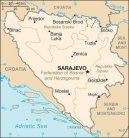| Introduction - Bosnia and Herzegovina: |
| Location - Bosnia and Herzegovina: |
| People - Bosnia and Herzegovina: |
| Government - Bosnia and Herzegovina: |
| Economy - Bosnia and Herzegovina: |
Economy overview | Bosnia and Herzegovina ranked next to Macedonia as the poorest republic in the old Yugoslav federation. Although agriculture is almost all in private hands, farms are small and inefficient, and the republic traditionally is a net importer of food. The private sector is growing and foreign investment is slowly increasing, but government spending, at nearly 40% of adjusted GDP, remains unreasonably high. The interethnic warfare in Bosnia caused production to plummet by 80% from 1992 to 1995 and unemployment to soar. With an uneasy peace in place, output recovered in 1996-99 at high percentage rates from a low base; but output growth slowed in 2000-02. Part of the lag in output was made up in 2003-06 when GDP growth exceeded 5% per year. National-level statistics are limited and do not capture the large share of black market activity. The konvertibilna marka (convertible mark or BAM)- the national currency introduced in 1998 - is pegged to the euro, and confidence in the currency and the banking sector has increased. Implementing privatization, however, has been slow, particularly in the Federation, although it is increasing in the Republika Srpska. Banking reform accelerated in 2001 as all the Communist-era payments bureaus were shut down; foreign banks, primarily from Western Europe, now control most of the banking sector. A sizeable current account deficit and high unemployment rate remain the two most serious economic problems. On 1 January 2006 a new value-added tax (VAT) went into effect. The VAT has been successful in capturing much of the gray market economy and has developed into a significant and predictable source of revenues for all layers of government. The question of how to allocate revenue from VAT receipts is not completely resolved. Bosnia and Herzegovina became a member of the Central European Free Trade Agreement in December 2006. The country receives substantial reconstruction assistance and humanitarian aid from the international community but will have to prepare for an era of declining assistance. |
|
Gdp purchasing power parity | $25.28 billion
note: Bosnia has a large informal sector that could also be as much as 50% of official GDP (2006 est.) |
|
Gdp official exchange rate | $9.217 billion (2006 est.) |
|
Gdp real growth rate | 6% (2006 est.) |
|
Gdp per capita ppp | $5,600 (2006 est.) |
|
Gdp composition by sector | agriculture: 14.2%
industry: 30.8%
services: 55% (2002) |
|
Labor force | 1.026 million (2001) |
|
Labor force by occupation | agriculture: NA%
industry: NA%
services: NA% |
|
Unemployment rate | 45.5% official rate; grey economy may reduce actual unemployment to 25-30% (31 December 2004 est.) |
|
Population below poverty line | 25% (2004 est.) |
|
Household income or consumption by percentage share | lowest 10%: NA%
highest 10%: NA% |
|
Distribution of family income gini index | 26.2 (2001) |
|
Inflation rate consumer prices | 8.2% (2006 est.) |
|
Budget | revenues: $5.643 billion
expenditures: $5.677 billion; including capital expenditures of $NA (2006 est.) |
|
Public debt | 24.5% of GDP (2006 est.) |
|
Agriculture products | wheat, corn, fruits, vegetables; livestock |
|
Industries | steel, coal, iron ore, lead, zinc, manganese, bauxite, vehicle assembly, textiles, tobacco products, wooden furniture, tank and aircraft assembly, domestic appliances, oil refining |
|
Industrial production growth rate | 5.5% (2003 est.) |
|
Electricity production | 12.98 billion kWh (2004) |
|
Electricity consumption | 11.03 billion kWh (2004) |
|
Electricity exports | 3.05 billion kWh (2004) |
|
Electricity imports | 2 billion kWh (2004) |
|
Oil production | 0 bbl/day (2004) |
|
Oil consumption | 23,000 bbl/day (2004 est.) |
|
Oil exports | NA bbl/day |
|
Oil imports | NA bbl/day |
|
Oil proved reserves | 0 bbl |
|
Natural gas production | 0 cu m (2004 est.) |
|
Natural gas consumption | 300 million cu m (2004 est.) |
|
Natural gas exports | 0 cu m (2004 est.) |
|
Natural gas imports | 300 million cu m (2004 est.) |
|
Current account balance | -$1.73 billion (2006 est.) |
|
Exports | $3.5 billion f.o.b. (2006 est.) |
|
Exports commodities | metals, clothing, wood products |
|
Exports partners | Croatia 19.1%, Slovenia 17%, Italy 15.6%, Germany 12.5%, Austria 8.8%, Hungary 5.3%, China 4% (2006) |
|
Imports | $8.25 billion f.o.b. (2006 est.) |
|
Imports commodities | machinery and equipment, chemicals, fuels, foodstuffs |
|
Imports partners | Croatia 25.1%, Germany 14.3%, Slovenia 13%, Italy 9.9%, Austria 5.9%, Hungary 5.1% (2006) |
|
Reserves of foreign exchange and gold | $2.7 billion (2006 est.) |
|
Debt external | $3.927 billion (2006 est.) |
|
Economic aid recipient | $650 million (2001 est.) |
|
Currency code | konvertibilna marka (convertible mark) (BAM) |
|
Exchange rates | konvertibilna maraka per US dollar - 1.5576 (2006), 1.5727 (2005), 1.5752 (2004), 1.7329 (2003), 2.0782 (2002)
note: the convertible mark is pegged to the euro |
|
| Communications - Bosnia and Herzegovina: |
| Transportation - Bosnia and Herzegovina: |
| Military - Bosnia and Herzegovina: |
This page was last updated on 16 September, 2007


